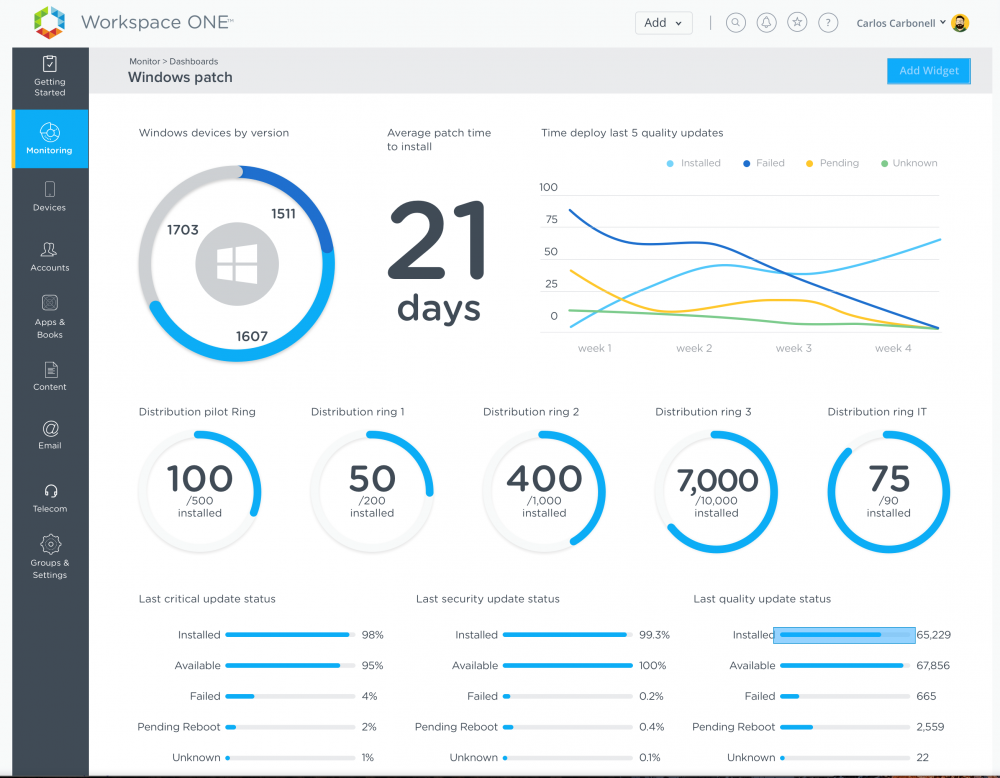June 20, 2019 by Siobhan Climer and Jason Wankovsky
Information technology specialists today are tasked with managing applications (legacy, SaaS, mobile, etc.), securing devices, applying access controls, and other digital workspace management realities in an increasingly boundless, complex environment.
 The growing complexity of managing this universe has led to increased incidences of so-called “Shadow IT”, where users find work-arounds for little inconveniences, bypassing IT and bringing increased risk to the organization.
The growing complexity of managing this universe has led to increased incidences of so-called “Shadow IT”, where users find work-arounds for little inconveniences, bypassing IT and bringing increased risk to the organization.
Digital workspace management platforms seek to consolidate the management of the network into a single dashboard or application that provides visibility into the devices accessing the network, the applications – wherever they live – users access, and the actions the users take once inside the network.
These digital workspace management platforms reduce shadow IT events and enable more secure BYOD policies for the business.
Why Do You Need Digital Workspace Management Platforms In The First Place
As we wrote earlier this year, the infosec word of the year is visibility. By visibility we mean knowing the inner goings-on of your network. Mishaal Khan, Certified Ethical Hacker and Security Practitioner has this to say about the importance of visibility:
“You don’t know what you don’t know.”
Wise words, right? It’s a simple truth: without visibility you can’t prevent or respond to threats.
Digital workspace management platforms work on this same principal. By having visibility into how users, even highly-authorized users, are utilizing and maneuvering in your network, you are better able to manage the applications and controls needed to optimize and secure your environment.
A Simple Dashboard Offers Visibility
Visibility is only useful if it’s useable. That’s why a simple integrated dashboard that provides a unified interface, giving IT visibility and control over digital assets, is integral to the best digital workspace management platforms.
Here’s an example of such a dashboard from VMware Workspace ONE:
Are you certain you have complete visibility into your network? A second set of expert eyes can help you spot possible gaps in your environment. Our expert engineers are happy to talk with you about your current configurations or provide assessments to give you insights.
Digital Workspace Management Platforms And Security Controls
 Users installing rogue applications or disabling a pesky virus scanner run great risk to the business. These insider threats run parallel to outside threats, such as ransomware or data breaches. Identifying and mitigating these threats is a central element of IT.
Users installing rogue applications or disabling a pesky virus scanner run great risk to the business. These insider threats run parallel to outside threats, such as ransomware or data breaches. Identifying and mitigating these threats is a central element of IT.
Digital workspace management platforms work using conditional compliance and dynamic controls that give users more control and flexibility, while at the same time ensuring IT has visibility into what users do. By embracing the real needs of users, digital workspace management platforms diminish the obstacles users face.
To do so, digital workspace management platforms provide one central application catalog users can use to find the solutions they need, without having to go through red tape. These catalogs require multi-factor authentication and conditional compliance controls that ensures IT has visibility into work-related apps and data.
A Tool For A New Workforce Operating In A New Workspace
Today, IT is faced with a growing number of devices – from personal smartphones and laptops to smart speakers and printers – and users are more comfortable installing applications and bypassing security controls.
Digital workspace management platforms provide a centralized, integrated took for IT professionals, ensuring the business continues to deliver on an optimized experience for their customers and their every day users.
Want to see digital workspace management platforms in action? Talk with our experts today.
Contact us today to discuss digital workspace management platforms.
Like what you read?
About Mindsight
Mindsight, a Chicago IT services provider, is an extension of your team. Our culture is built on transparency and trust, and our team is made up of extraordinary people – the kinds of people you would hire. We have one of the largest expert-level engineering teams delivering the full spectrum of IT services and solutions, from cloud to infrastructure, collaboration to contact center. Our highly-certified engineers and process-oriented excellence have certainly been key to our success. But what really sets us apart is our straightforward and honest approach to every conversation, whether it is for an emerging business or global enterprise. Our customers rely on our thought leadership, responsiveness, and dedication to solving their toughest technology challenges.
Contact us at GoMindsight.com.
About The Author
Siobhan Climer, Science and Technology Writer for Mindsight, writes about technology trends in education, healthcare, and business. She previously taught STEM programs in elementary classrooms and museums, and writes extensively about cybersecurity, disaster recovery, cloud services, backups, data storage, network infrastructure, and the contact center. When she’s not writing tech, she’s writing fantasy, gardening, and exploring the world with her twin two-year old daughters. Find her on twitter @techtalksio.
Jason Wankovsky is the Chief Technology Officer and Vice President of Consulting Services at Mindsight, an IT Services and Consulting firm located in the Chicago area. Jason has over 20 years of experience in IT management and executive leadership and is responsible for Mindsight’s technology vision. He is also focused on the creation and delivery of high value managed services for clients across multiple industries. Jason leads the solution architecture team that is responsible for delivering optimal technology services and solutions that enable the businesses of clients.





